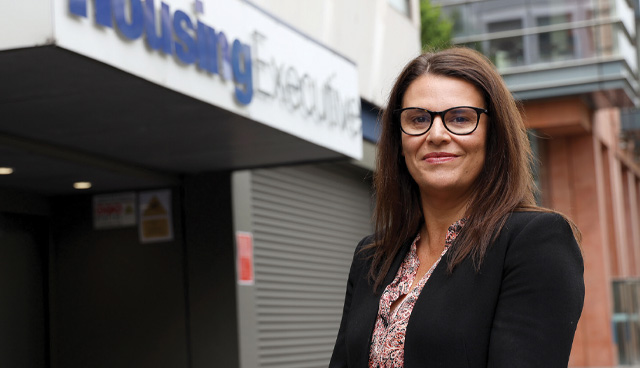Partnership and planning key to tackling homelessness during Covid-19

Coronavirus presented huge challenges to us all. For the Housing Executive, a key focus was delivering services for some of the most vulnerable in our society and those most in need, those experiencing homelessness.
Caroline Connor is Assistant Director with responsibility for Homelessness at the strategic housing authority and she was tasked, with her team, with navigating a complex and critically essential role during a global pandemic. Here, she talks to agendaNi about the steps taken to protect those experiencing homelessness during Covid-19 and how partnership work, enshrined in the body’s Homelessness Strategy, Ending Homelessness Together, proved key.
During Covid-19, our aims from the outset have been to safeguard as many people experiencing homelessness as we can and to ensure that we could enable homelessness services to operate effectively and respond safely.
The scale of the challenge we faced and continue to face is unprecedented.
And we weren’t alone in facing that challenge. We’ve worked closely with local homelessness sector service providers, as well as our sponsoring department, the Department for Communities, along with the Department of Health and the Public Health Agency in Northern Ireland to put our plans into action.
We quickly recognised that the pandemic could potentially impact on how we deliver our statutory duties in providing services to those experiencing homelessness and we put in place alternative working arrangements.
Our initial priority was limiting the transmission of the virus among those experiencing homelessness. This started with a commitment that no-one, anywhere in Northern Ireland, would be left on the streets, including those with no recourse to public funds. This move was supported by our Board.
We worked with homelessness service providers to ensure social distancing guidelines were, and continue to be, applied. We looked at services where it was difficult for people to practice social distancing or self-isolation, such as night shelters and day centres and these organisations quickly took action to alter how they deliver services. Accommodation and floating support services were also reconfigured to enable this to happen.
With the added challenge of the bulk of our staff working from home, to comply with social distancing protocols, this was all achieved. Although challenging, to date no services have ceased operations.
Planning for a pandemic
In early March, the general public became alarmed when Europe’s major cities, like Milan and Madrid, started to lockdown. Our entire organisation moved quickly into contingency planning mode as we began preparing for a rapidly approaching time when Northern Ireland would face a similar situation.
A Central Co-ordinating Group was established, supported by our senior management team and Board, to deliver our response. By mid-March, we had developed a surge plan for homelessness services which set out comprehensive contingency arrangements and escalation measures to support services to continue during the containment and surge phases of the outbreak.
This co-ordination, in conjunction with the Supporting People Programme and its providers, enabled contingency planning across the sector. It ensured delivery with other statutory bodies, including the Public Health Agency, and copper-fastened communication and engagement with our key stakeholders.
Our arrangements had two basic aims: The first was safeguarding those experiencing homelessness from Covid-19. The second was ensuring homelessness services continued to operate effectively and safely.
Information provision
Our Supporting People team shared Public Health Agency (PHA) and Central Government Guidance with all service providers; to guide planning, preparation and coordination around Covid-19, including relevant guidance on social distancing and information allowing homeless people who had contracted Covid-19 to self-isolate.
While each service provider had responsibility for its own business continuity and safety measures during the Covid-19 outbreak, our advice and guidance was consistent.
Delivering our contingency plans
By Friday, 9 May, 2,884 households were in temporary accommodation placements across Northern Ireland.
It was hugely challenging to predict accurately where the impact on homelessness services would be greatest, given the unprecedented nature of Covid-19.
We quickly boosted the availability of temporary accommodation, despite many non-standard accommodation providers (those in the hotel and bed and breakfast sector) having closed their doors.
People without recourse to public funds were also given accommodation, to maintain public health, and some of those who are the most hard to reach, those who rough sleep, accepted placements, when offered.
We received £3.3 million additional funding from the Department for Communities, while our Minister recently announced a further £10 million for the Supporting People programme partners.
Assessments for homelessness continued, despite offices being closed, via emergency appointment or by telephone, including out-of-hours services for emergency accommodation.
The impact was visible, there were no individuals reported as rough sleeping.
Coping during the crisis
Homelessness trends from the beginning of April appear to be changing, compared to previous years.
While the overall numbers of people presenting to us has reduced, the number of those requiring temporary accommodation has increased.
Year on Year comparisons for the month of April in both 2019 and 2020 are stark.
In Belfast, those accepting temporary accommodation more than doubled. Figures show numbers jumped from 156 in April 2019 to 413 in April 2020.
In the West area, stretching across Derry/Londonderry, Tyrone and Fermanagh, the picture was similar, rising from 56 in 2019 to 109 in 2020.
The reasons for people presenting to us for support are also changing.
For the last five years the most common reason for homelessness has been linked to unreasonable accommodation.
During Covid-19, family sharing breakdown, domestic disputes or marital difficulties were the key reasons for people seeking assistance.
While the numbers presenting due to neighbourhood harassment and domestic violence remained the same, the overall proportion of presentations due to these reasons is largely due to the overall drop in the numbers of homeless applications compared to April 2019.
This provides an insight into the stresses wider society is facing during lockdown. 75 per cent of those presenting came as single persons. 21 per cent were families with children. 69 per cent were male and 31 per cent were female. The numbers of females presenting to us has increased.
We have used a range of accommodation, both supported and unsupported, to meet needs.
This includes single lets (a self-contained property like a house or flat, sourced via the private rented sector, where the household are sole occupants), voluntary hostels and Housing Executive hostels.
However, it was necessary to source accommodation through hotels and bed and breakfast providers to cope with demand and allow social distancing to be applied.
Positively, the number of those presenting after losing private rented accommodation has reduced significantly, an indication that measures such as the passing of the Private Tenancies (Coronavirus Modifications) Bill by the Northern Ireland Assembly has strengthened protection to private renters during the Covid-19 crisis.
We now need to work to sustain these tenancies going forward.
Permanently changed environment
We’re currently developing an Exit Strategy and contingency plans for a possible second wave of Covid-19.
We want to reflect and build on some of the positive work that has come out of this challenging time.
We view this as an opportunity to ‘reset’ rather than ‘revert’ to old.
We want to build on what we have learned to inform how we will operate in what we believe will be a permanently changed environment post Covid-19.
Our vision for our Homeless Strategy 2017-2022 was to end homelessness together, during these unprecedented times, we’ve proved what can be done collaboratively.
And it is collaboratively that we will plot the route through this changed environment to identify long term sustainable outcomes to the issue of homelessness.






